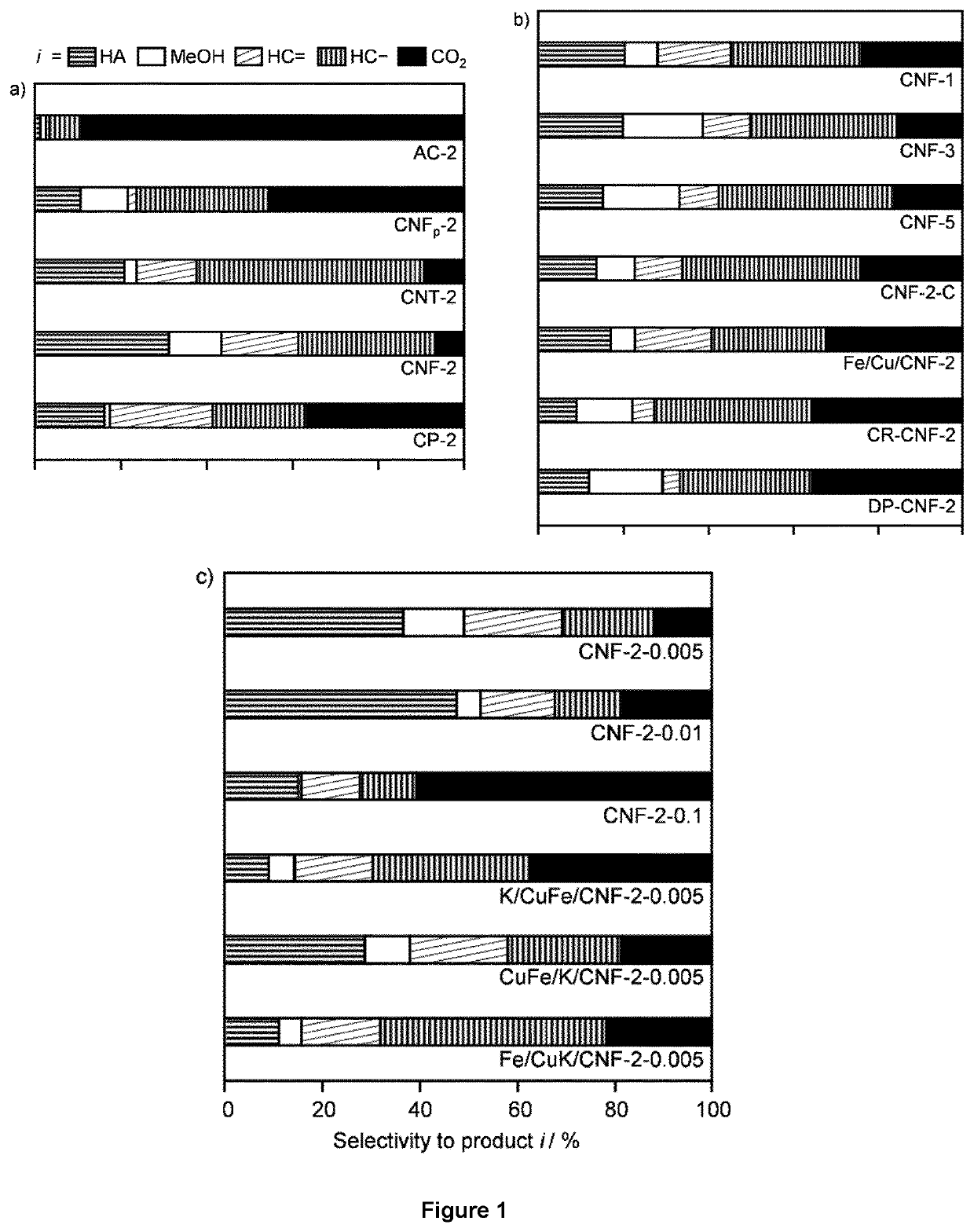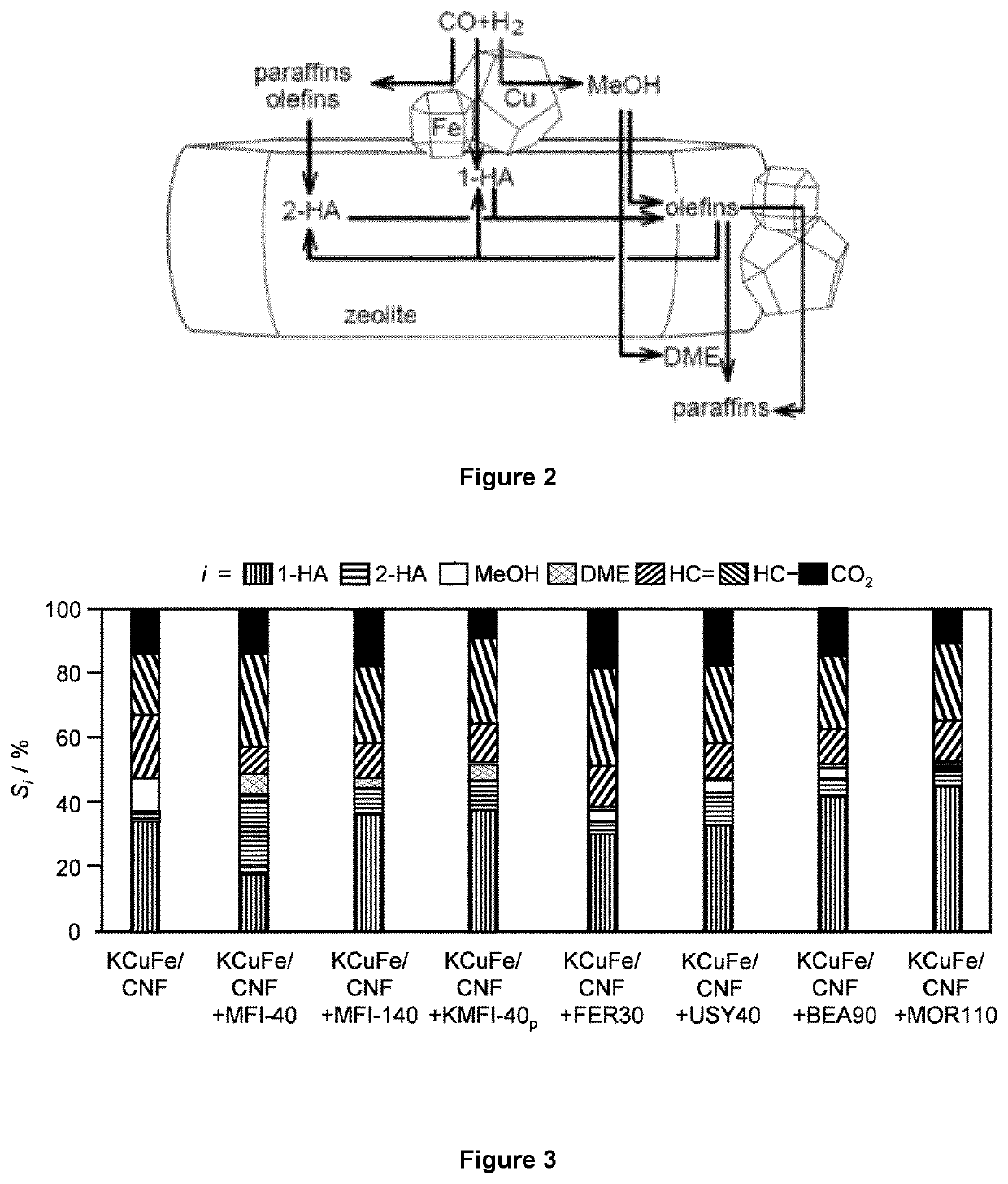Process using catalytic composition for the conversion of syngas to higher alcohols
- Summary
- Abstract
- Description
- Claims
- Application Information
AI Technical Summary
Benefits of technology
Problems solved by technology
Method used
Image
Examples
example 1
lysts Preparation
[0254]Bulk Catalyst
[0255]A bulk Cu—Fe catalyst with nominal molar Cu / Fe=2 was prepared by co-precipitation using Na2CO3 as the precipitating agent. Cu(NO3)2.3H2O (5.283 g, Aldrich Fine Chemicals, 98-103%) and Fe(NO3)3. 9H2O (4.406 g, Aldrich Fine Chemicals, >98%) were dissolved simultaneously in deionised water (65.6 cm3) yielding a solution with a total metals concentration of 0.5 M. The mixture was magnetically stirred at 343 K while adding a 0.5 M Na2CO3 solution (81-83 cm3, 2 cm3 min−1) to reach a pH of 8. The slurry obtained was aged for 3 h, washed with water (3 dm3), dried at 343 K, calcined at 723 K, and reduced in a 10 vol. % H2 / He flow of 20 cm3 min−1 for 4 h at 673 K (ramp rate=3 K min−1).
[0256]Supported Catalysts
[0257]Supported Cu—Fe catalysts with nominal molar Cu / Fe molar ratios of 1, 2, 3, or 5, and a Cu—Fe loading of 5 wt. % were prepared by a sol-gel method (SG). K was added as a promoter to the materials with Cu / Fe=2 in a nominal molar K / Cu—Fe mola...
example 2
K Promotion on CNF-Supported Cu—Fe Catalysts
[0263]The impact of potassium as a promoter was studied on CNF-2. Three materials were prepared including different amounts of the alkali metal upon deposition of Cu and Fe so to reach nominal K / CuFe ratios of 0.005, 0.01 and 0.1. In addition, since the K loading is very small and falls below the detection limit of many characterisation techniques, it was attempted to gather insights into its role by varying the location and contact of this promoter with the active metals tailoring the synthesis method.
[0264]Hence, K was incorporated prior to or after the simultaneous deposition of Cu and Fe (CuFe / K / CNF-2-0.005 and K / CuFe / CNF-2-0.005) and along with Cu prior to Fe addition (Fe / CuK / CNF-2-0.005). The measured Cu / Fe ratio and Cu—Fe loading of the reduced catalysts were close to the nominal values (see Table 1), but the K loadings were systematically lower than expected, likely due to the presence of moisture in K2CO3.
[0265]When K was introduc...
example 3
terial
[0274]MFI zeolites with nominal Si / Al molar ratios of 40 and 140 (CBV8014 for 40 and CBV28014 for 140, Zeolyst Ltd., denoted as MFI-x, where x is the Si / Al molar ratio) and FER zeolites with nominal Si / Al molar ratio of 27.5 (CP 914, Zeolyst Ltd., denoted as FER30) were delivered in ammonium form and calcined as described above, to convert them into the corresponding protonic forms. MFI-40 samples partially (KMFI-40p) were obtained by treatments of the as-received MFI-40 in aqueous KNOB (1.0 mM and 0.1 M, respectively, 10 gzeolite dm−3, 8 h). The zeolite recovered by filtration was washed with deionized water (1 dm3 gzeolite−1), dried, and calcined under the same conditions as for the other samples.
[0275]USY zeolites with nominal Si / Al molar ratio of 40 (CBV780, Zeolyst Ltd., denoted as USY40), BEA zeolites with nominal Si / Al molar ratio of 90.5 (HCZB150, Clariant, denoted as BEA90), and MOR zeolites with nominal Si / Al molar ratio of 110 (690HOA, TOSOH, denoted as MOR110) were...
PUM
| Property | Measurement | Unit |
|---|---|---|
| Temperature | aaaaa | aaaaa |
| Temperature | aaaaa | aaaaa |
| Pressure | aaaaa | aaaaa |
Abstract
Description
Claims
Application Information
 Login to View More
Login to View More - R&D
- Intellectual Property
- Life Sciences
- Materials
- Tech Scout
- Unparalleled Data Quality
- Higher Quality Content
- 60% Fewer Hallucinations
Browse by: Latest US Patents, China's latest patents, Technical Efficacy Thesaurus, Application Domain, Technology Topic, Popular Technical Reports.
© 2025 PatSnap. All rights reserved.Legal|Privacy policy|Modern Slavery Act Transparency Statement|Sitemap|About US| Contact US: help@patsnap.com


